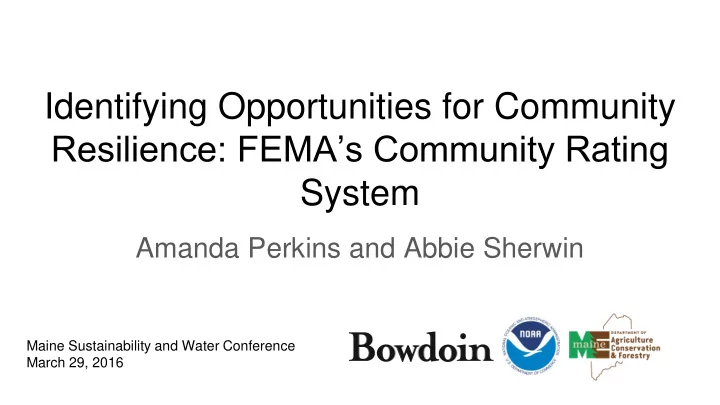

Identifying Opportunities for Community Resilience: FEMA’s Community Rating System Amanda Perkins and Abbie Sherwin Maine Sustainability and Water Conference March 29, 2016
Presentation Overview • CRS and community resilience • CRS in Maine • Opportunities for CRS credit • Developing a transferable model for assessing potential CRS credit • Implications for state and local geospatial data
The Community Rating System (CRS) • Voluntary NFIP program that offers discounts on flood insurance in exchange for actions that reduce flood risk within a community • Incentivizes resilience, alleviates increasing flood insurance costs, and makes communities and residents safer from flooding • Municipalities participate in the program
Goals of CRS 1. Reduce flood damage to insurable property 2. Strengthen and support the C. Adams 9/30/15 insurance aspects of the NFIP 3. Encourage a comprehensive approach to floodplain management
CRS Rating Table
CRS Activity Categories • Public Information Newsletters, brochures, presentations, reading flood maps • Flood Damage Reduction Acquisition/relocation, mitigation, hazard planning • Warning and Response Flood emergency response and warnings • Mapping and Regulations Stormwater management, open space preservation ,
Open Space Preservation • Objectives o Prevent flood damage by keeping flood- prone lands free of development o Protect and enhance the natural functions of floodplains • Credit for development restrictions (local regulations & individual property owners) rOSP = aOSP aSFHA • Maximum possible credit points: 2,020 (avg. points earned: 463)
CRS in Maine Statewide 17 communities of 889 (2%) Coastal Zone 9 communities of 141 (6%)
Good News... Many communities are already doing things that would qualify for CRS credit • Comprehensive planning • Outreach and education • Building code • Freeboard • Shoreland Zoning Act
Overcoming Challenges to Increase Participation in CRS • What can be done Arduous requirements to facilitate • Strained resources participation and • Lack of capacity streamline the CRS process? • Incentive disparity
Collaborating to answer questions about CRS and Open Space Preservation in Maine
Only one of many possibilities!
CRS in Bath
Bath, ME Georgetown, ME Municipal Variation Damariscotta, ME Boothbay Harbor, ME
Bath, ME Ratios of open space in Bath, ME Georgetown, ME mmcclung on panoramio Ratios of open space in Georgetown, ME http://www.covesidebandb.com/aerial-images-of-georgetown-maine/
Gathering Data Public Data Source Bath Conserved Lands MEGIS Bath FEMA Flood Zones FEMA Bath KELT Forest Blocks MEGIS / Chris Cabot, KELT Bath Cemeteries Maine Old Cemetery Association and MEGIS Bath Schools MEGIS Bath Farms MEGIS Bath Waterbodies and USGS Wetlands
Data Formatting
There was no park layer for Bath (or any of the communities we studied)!
Lessons Learned Large Scale Lessons Small Scale Lessons - Paying attention to the CRS standards in - Building resilience to flooding (in ways writing legislation on the municipal or even incentivized by the CRS program) will take state level could help coastal communities largely different forms in different localities. to automatically qualify for insurance cost - The process of gathering relevant data for reductions. this analysis is valuable for communities in - It is important to collect data in widely itself. applicable formats. - Creative collaborations benefit many - The State especially may want to consider stakeholders and streamline resources. gathering information broadly about Please reach out to students and features such as parks that would be academic institutions; we want to work useful for a variety of municipal planning with you! initiatives.
Sources and Acknowledgements A special thanks to Bowdoin students Bailey Moritz (‘16), John Layman (‘18), and Greg Anrig (‘18) for their work on this project in partnering communities. Thanks to Professor Eileen Johnson for teaching us these skills and arranging community partner opportunities. Thanks to Abbie Sherwin, Liz Hertz, Pete Slovinsky, Chris Cabot, Bob Faunce, Andrew Deci, Brenda Cummings, and the Town of Georgetown for the support, advice and data they contributed to these projects. Other data sources included MEGIS, USGS, FEMA, KELT, Beginning with Habitat, and Bowdoin College.
Potential CRS cost savings for policyholders* in Bath and Georgetown *SFHA Zones
Recommend
More recommend